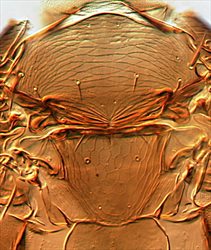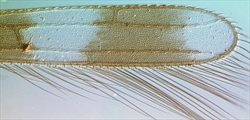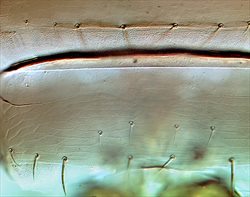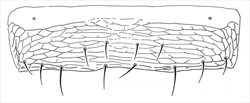
Head and thorax

Head

Antenna

Fore tarsus

Meso & metanota

Tip of fore wing

Female sternite VII

Female sternite VII
Both sexes fully winged. Female with fore wings bearing two transverse dark bands, apical ring vein dark. Body, legs and antennae brown, but antennal segment II pale at apex, III pale in basal half. Antennae 9-segmented, segment III with linear sensorium no more than one-third as long as segment, IV with sensorium about half as long as segment; segments V–IX forming a single unit with V considerably longer than VI–IX. Head and pronotum with no long setae. Fore tarsus apically with stout recurved ventral hamus. Metanotum reticulate. Marginal setae on sternites arising at or close to margin; distance between median marginal pair on VII usually less than 1.5 times the length of these setae; paired accessory setae on VII arising further from the margin than their length.
Male fore wings similar to those of female; tergites IV–V each with pair of irregular tubercles, IX with paired bifurcate claspers, also paired sickle-shaped setae.
Over 100 species are placed in the genus Aeolothrips, mostly from the Palaearctic Region but with about 30 from the Nearctic including the western USA. A. tenuicornis is a member of a Eurasian species-complex, and the females are particularly similar to those of propinquus, from which it is distinguished by the shorter sensoria on antennal segments III and IV, and the location of the paired accessory setae on sternite VII more distant from the posterior margin.
Presumably similar in biology to intermedius (see Bournier et al., 1979), living as a facultative predator on mites and thrips larvae in flowers. This species is associated with the flowers of various plants in the families Asteraceae, Cruciferae, and Fabaceae, often in yellow flowers.
Described from material collected in Surrey (Bagnall, 1926), this species is common across southern England, but has been widely recorded in northern Scotland (Mound et al., 1976). It is also recorded widely across central and southern Europe, as well as the Atlantic islands (zur Strassen, 2003), and is found in countries of the eastern Mediterranean, and further east in Iran (Alavi & Minaei, 2018).
AEOLOTHRIPIDAE
Aeolothrips tenuicornis Bagnall
Aeolothrips tenuicornis Bagnall, 1926: 280
Aeolothrips anthyllidis Bagnall, 1932: 161
Aeolothrips clavicornis Bagnall, 1934: 122
Aeolothrips bucheti Bagnall, 1934: 484
Aeolothrips ghabni Priesner, 1938: 215
Alavi J & Minaei K. (2018) Studies on the genus Aeolothrips (Thysanoptera: Aeolothripidae) in Iran, with a key to species. Zootaxa 4446 (3): 343–360.
Bagnall RS (1926) On some new British Thysanoptera. Entomologist’s Monthly Magazine 62: 279–285.
Bournier A, Lacasa A & Pivot Y (1979) Régime alimentaire d'un thrips prédateur, Aeolothrips intermedius (Thys.: Aeolothripidae). Entomophaga 24: 353–361.
Mound LA, Morison GD, Pitkin BR & Palmer JM (1976) Thysanoptera. Handbooks for the Identification of British Insects 1 (11): 1–79.
zur Strassen R (2003) Die terebranten Thysanopteren Europas und des Mittelmeer-Gebietes. Die Tierwelt Deutschlands 74: 1–271.